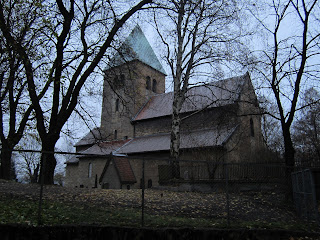This is the oldest standing building in the city of Oslo but in the Middle Ages this church was actually quite a bit far out in the countryside. It was really interesting to look at a map of medieval Oslo and see how drastically many parts of the landscape have changed. A lot of where there was ship access is completely developed land. While this was just a parish church it was almost as big as St Hallvard's Cathedral which means that the person who commissioned the building was quite rich. There's some argument about the dating of the church which depends on whether it was built before or after the cathedral in Hamar but my professor thinks the dating is approximately 1130-1140.
It was a eerie to be in the church with no lights on. The windows that are currently in place are about 60% bigger than the original windows so this gives some idea of what the church would have looked like on a regular foggy morning. The interior would have looked slightly brighter because the walls would have been whitewashed and painted with decorations.
I really enjoyed hearing my instructor's perspective because he works for the city protecting heritage sites and has a lot of opinions regarding the restoration of medieval sites. It made me think a lot about how our opinions on what a medieval church looks like effects how we restore these types of buildings. In a way we "medievalize" the medieval and are more concerned with matching our mental images than with historical accuracy. I typically think of the bare stone as a very medieval thing when it's the exact opposite. You can tell the cement-rock restored corners of the walls because they match the 'Ashler' style of rock shaping and setting that is seen on the exterior of the church while the original interior walls have much rougher shape. This is because those rocks would typically never been seen for the whitewash covering them and so did not need to be as precise. But because we like the almost primitive look of the bare stone we keep it instead of choosing authenticity.
This picture is of the side chapel to Mary that also functioned as the sacristy. It's the only room in the church with the barrel vaulting typically found in Romanesque churches while the rest of the building has flat roofs and this had a dual purpose. First it was symbolically exalting for the Mother Mary and second because it was a much more sturdy construction that protected this room and the valuables it contained from the numerous fires that damaged the rest of the building and from any would-be burglars.
 |
| Super weird little baptismal font. I think from the 17th century. |
 |
| the only existing piece of figurative sculpture on the whole church. It's a snake biting its own tale signifying eternity/infinity. |
-Ash the Viking.
Also, this blog has gotten over 1400 views. :D Awesome!







No comments:
Post a Comment